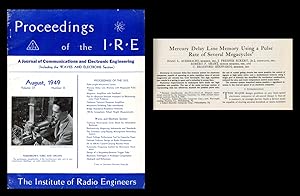eckert presper john adam isaac (1 résultats)
Type d'article
- Tous les types d'articles
- Livres (1)
- Magazines & Périodiques
- Bandes dessinées
- Partitions de musique
- Art, Affiches et Gravures
- Photographies
- Cartes
-
Manuscrits &
Papiers anciens
Etat
- Tous
- Neuf
- Ancien ou d'occasion
Reliure
- Toutes
- Couverture rigide
- Couverture souple
Particularités
- Edition originale
- Signé
- Jaquette
- Avec images
- Sans impression à la demande
Pays
Evaluation du vendeur
-
Mercury Delay Line Memory with Megacycle Pulse Rate" in Proceedings of the IRE 37 No. 8 pp. 855-861, August 1949
Edité par The Institute of Radio Engineers, 1949
Vendeur : Atticus Rare Books, West Branch, IA, Etats-Unis
Edition originale
1st Edition. FIRST EDITION IN ORIGINAL WRAPPERS OF A PAPER BY PRESPER ECKERT, et al. DESCRIBING THE DEVELOPMENT OF THE HIGH-SPEED MERCURY DELAY LINE MEMORY FOR COMPUTER APPLICATIONS. The acoustic delay line was invented by William Shockley in 1942 and developed by Presper Eckert in 1943 using mercury for a radar application. It was later developed for use in computers by Eckert and became the first widely accepted computer memory system. "A delay line stores information in serial form by continuously circulating data through a liquid or solid medium. A piezo-electric transducer converts a digital electronic signal into a series of pulses that travel through the line. A second transducer receives and amplifies the signal for transmission back to the source. Information is recirculated until accessed or changed by the computer. The physical length of a line determines the amount of information that may be stored. John Adam Presper Eckert Jr. (1919-1995) was an American electrical engineer and computer pioneer. With John Mauchly, he designed the first general-purpose electronic digital computer (ENIAC). Employing Shockley's 1942 invention of the acoustic delay line, Eckert developed them using mercury-filled tubes and adapting them to reduce clutter in WWII radar systems. In 1947 he filed for a patent on his development specific to data storage - computer memory systems. Using Eckert's patent, in May 1949 Maurice Wilkes built EDSAC (Electronic Delay Storage Automatic Calculator), the first full-size stored-program computer, at the University of Cambridge Mathematical Laboratory, England with 512 35-bit words of memory, stored in 32 mercury delay lines holding 576 bits each. The first UNIVAC computer shipped to the U.S. Census Bureau in 1951 included seven 1.5 KB memory units with an average access time of 222 microseconds" (Computer History Museum). Each unit held 18 of Eckert's mercury-filled tubes, together weighing a full 800 lbs. CONDITION & DETAILS: 4to. Complete issue in original paper wrappers. Some minor scuffing at the edges of the wrappers. Clean and bright throughout. Very good condition.


